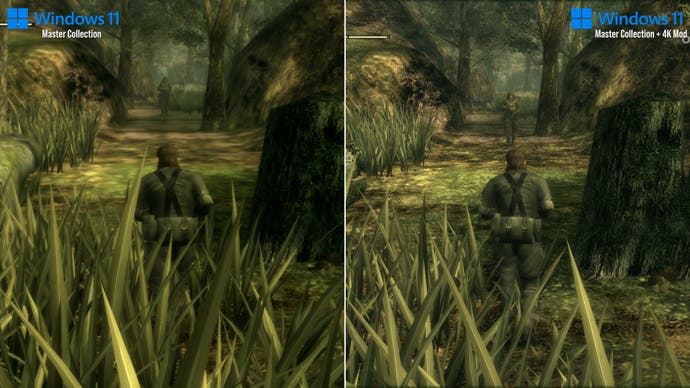Metal Gear Solid Master Collection Vol. 1 is anything but masterful
A litany of issues and an incredible lack of ambition make this a hard 'avoid'.
Much has already been said about the woeful state of Metal Gear Solid Master Collection: Volume 1. The idea is certainly enticing on paper: for £50/$60, Konami promises us seven main entries in the series in one package for current-gen and last-gen consoles plus PC.
The content here is not the issue. We get the PS1 classic MGS, with the VR missions pack included, we get MGS2: Sons of Liberty and MGS3: Snake Eater, with enhancements from the later Substance and Subsistence versions. And to sweeten the deal, there's the MSX2 releases of Metal Gear and Metal Gear 2: Solid Snake, while both NES Metal Gears make a rare appearance too for a series collection. That takes us from the series' inception in 1987 right up to MGS3 in 2004, with room for a Master Collection Volume 2 to expand beyond that.
There are omissions of course, but it would have been enough if each game had been ported to current-gen consoles with the love and attention they deserve - but sadly, this isn't the reality. Regardless of which platform you buy the Master Collection on, and despite some admittedly nice extras on the front-end, this release could and should have been so much more.
The bottom line is that the Master Collection presents the core Metal Gear Solid 1, 2 and 3 games with limited enhancements over any previous release. The older MSX and NES games are largely fine as they are - given their 2D sprite-based nature - but the series' move to 3D from the Playstation era onwards does demand a more involved update. The first MGS, for example, runs via an emulator at the same 240p resolution and frame-rate as original PS1 hardware. Meanwhile the Playstation 2 duo - MGS2 and 3 - use code from the 2011 Bluepoint HD Collection versions for Xbox 360 and PS3. The changes to their visuals in the Master Collection are minimal at best, meaning we still get a native 1280x720 presentation on both games for PS5, Series X/S and Nintendo Switch.
More shocking still is the treatment of the PC version. Both MGS2 and 3 run at the same fixed 720p resolution on PC, with no graphics menu to boost the resolution - though there are user workarounds. It's disappointing stuff, especially given Konami's suggestions before release that these games might target 1080p. In truth, it's disappointing to see how barebones the final results are.
With so many games and platforms to cover off, we have to pick our targets for a tech analysis. Today then, I'm honing in on the pitfalls present on PS5, Series X, Switch and PC, which certainly give us enough issues to talk on. Every version has problems, but some - most notably Switch - are much worse off in terms of both visuals and frame-rate.

Let's start with the good news before we get to the bad. Each game has a slick and responsive front-end menu built on the Unity engine that's crammed with extras. There are extensive language options, a digital master book for each title that breaks down every character and backstory, a jukebox, screenplays for all seven games (with MGS3 impressively offering up a 900-page manuscript) and even voiced graphic novels for MGS1 and 2. You also get every variation of the PS1 Metal gear Solid: from the 1998 original, the VR/Special Missions expansion discs for Europe and North America, and the Japan-only Integral release.
For a Metal Gear completionist, it's great to have all of this in one place. The only downside perhaps is that the Master Collection doesn't tie everything together with a single front-end. Instead, to allow each game to be bought separately - for £16 apiece - they're partitioned away as seperate apps on the console system menu, which is a shame.
The original Metal Gear Solid in the Master Collection plays it very safe, with no differences playing it between PS5, Series X, Switch or PC due to a straight emulation approach handled by developer M2. As such, many of the quirks of the original PS1 game are preserved: a base resolution of 320x240, and PS1's signature affine texture warping that causes texture maps to 'wobble' as you move the camera. The one upside is that the dithering of the PS1 original is removed for this release, giving us a cleaner image. Hardware clock speeds are simulated too, meaning we get an authentic 30fps cap with hard drops to 20fps and under, normally in the first-person view.
There's also a trick to getting the best MGS1 experience from the collection. If you select UK English or a European language from the front-end, the Master Collection defaults to the European version of MGS1, capped at 25fps to suit the 50Hz PAL standard - not ideal. The good news is that the Master Collection also includes the North American NTSC version as an optional download if you select English US, which does provide the smoother 30fps cap, meant for a 60Hz container. While it's great we have both PAL and NTSC versions available for the completist, it's odd that these 60Hz NTSC US and Japanese releases involve an extra download. These really should be the default.
Sticking to the English US version, it's clear M2 opted for a no-frills approach here. There are scarse visual extras beyond swapped button prompts to suit modern consoles, and themed borders. There aren't any options to scale the image or CRT filters, for example, though Konami has promised more video options in a future update. Ultimately we're left with a very basic - if faithful - rendition of the game. The only tweak made here is the forcing of bilinear filtering to the image, which softens the image - and text elements. It's removable on PC via a mod, but for PS5, Series X and Switch this filter is fixed in place. Also, sound emulation is sadly inaccurate in this Master Collection release, with a crackling effect kicking in at points - a common problem with PS1 reverb emulation.
All-round, MGS1's delivery on modern day consoles leaves so much on the table. Even a native 1080p or 4K version of the game would have been a hugely welcome extra, and looking at PS1 emulators on PC like Duckstation, forcing higher resolutions allows for surprisingly good results. It's even possible to remove the PS1's texture warping issues, if you wish. I'm not expecting every console to hit a 4K resolution in the Master Collection, but offering some option in this vein seems appropriate for PC, PS5 and Series X given the power on tap. As it stands though, MGS1 fans are treated to a huge wealth of great extras in the Master Collection front-end - the master book, the script, and multiple versions - but the game itself looks and plays much like it did back in 1998.
The MGS2 and MGS3 parts are where the bigger frustrations begin. In essence, both of these games are the same as HD Collection versions released in 2011 on Xbox 360 and PS3 of course, and there's no attempt to disguise the fact either. In booting either of these games, you'll even catch a flash of the old HD Collection logo in the bottom right.
With that in mind, the content of each game is much the same as it was on PS3 and 360, though with the MSX2 Metal Gear and Metal Gear 2 games removed from the MGS3 menus and put in their own separate app. One more straightforwardly positive change I noticed is that the delay on codec dialogue in MGS2 has been reduced compared to the 2011 HD Collection. The three second delay there is minimised to closer to a single second. It's likely an incidental benefit of running either game from SSD-equipped modern consoles, but it's a clear plus.
Jumping to the comparisons, this is where the problems show up. Switch, Xbox Series X and PS5 all sport a native 720p resolution, but anti-aliasing (AA) quality differs between all three consoles, notably in MGS2 where PS5 offers the most thorough treatment of rough edges. On the other hand, Nintendo Switch leaves all these edges entirely raw without any AA whatsoever, creating heavy visual noise and flickering, especially in motion. There's something off with Series X too. This features a form of anti-aliasing in parts to reduce moire patterns, yet elements of the image are left untreated with a similar result to the AA-less Switch version. The upside is that Metal Gear Solid 3 at least gets AA across the board, on all three consoles.
Texture filtering is problematic too, with PS5 running at a much higher anisotropic filtering setting than Series X. And once again Switch loses out in this aspect, with zero texture filtering applied to any surface - causing pixellated noise across busy textures. The upside for Switch is, much like its AA issue, texture filtering is at least engaged in the MGS3 portion of the collection. Overall, across both PS2-era games, PS5 does ends up with the best image quality by a solid margin, especially in MGS3 where the camera is fully controllable to reveal the filtering advantage.
The anti-aliasing and texture filtering urgently need fixing on Series X and Switch. It's a bizarre situation on Series X as well, given the Master Collection produces a worse image than what we already had in the Xbox 360 HD Collection, running in back-compat on Series X. The older 2011 release includes anti-aliasing for a start - and by running it on a Series X via back-compat, higher-grade texture filtering is forced. In other words, running your old copy of the HD Collection on Series X produces better results than this new collection from Konami. Check out the comparison shots a little higher in this piece to see the difference - it's quite stark.
In terms of performance, there's plenty of disappointments too. On the plus side first, MGS2 and MGS3 at least run at 60fps on PS5 and Series X without much issue, though cutscenes are designed to run at a mix of 60, 30 and 15fps at points in MGS2. These drops are hard-baked design choices that carry over from the PS2 days, as Hideo Kojima appeared to use frame caps for dramatic effect. It's a flourish that stays on modern consoles, but as far as the core gameplay goes, both games run at 60fps. No problems here.
The situation on Nintendo Switch is less encouraging though. Whether docked or played as a portable, both games run with a 30fps cap. That's a big setback next to the HD Collection, which runs at 60fps on older 360 and PS3 hardware - and even on PS2, MGS2 was built to run at 60fps. This 30fps cap on Switch has a domino effect on the game's motion blur effect, too, causing more notable banding behind camera movement. In boss battles it causes any first-person shooting to turn the picture into a blurry mess. I'm glad to say this blur effect is at least removed for the Raiden section later on though, and in MGS3.
For Switch and its Tegra X1 chipset, there's clearly a bottleneck to getting either game running at 60fps, but the problems don't end there. Sadly the 30fps cap isn't even well-implemented with uneven frame pacing, creating juddery movement and drops below 30fps. Typically MGS2 fares worst, and this game appears to be a lightning rod for the collection's most glaring problems. In MGS2 we get lurches into the low 20s on first meeting Fortune, for example, and 18fps in long shots of the oil rig. Switch just isn't coping here, even at 720p with zero anti-aliasing. Oddly enough, there are flashes of uncapped 60fps gameplay in MGS2 on Switch - in opening lockers or doors - despite the 30fps cap being fixed 99 per cent of the time.
Switch is in a bizarre state as it stands then. These sub-30fps drops in MGS2 stand at odds with the Nvidia Shield version of the game, from which the Switch version is seemingly derived. On Shield the game runs at 60fps, though this is aided of course by using a higher-clocked Tegra X1 than Switch's. Still it begs the question: how far off the mark is Switch from hitting 60fps on a game that's fundamentally over 20 years old?
Booting up the PC version of MGS2 and MGS3 in the Master Collection provides perhaps the biggest shock of all. Here again we have a fixed 720p rendering of both games with no settings menu, and therefore no way to adjust basic video settings like AA, rendering resolution, aspect ratios or output resolution. You only get a choice between windowed and borderless full-screen in certain titles. There's also no way to re-bind keyboard or mouse inputs, but at least you get this minor level of support for non-controller inputs here.
Oddly, the MGS2 portion on PC also has the bigger visual issues. Much like Switch, the game runs at 720p with zero anti-aliasing whatsoever, creating a busy, noisy image, though AA appears in MGS3 at least. Both games also use a very low-quality texture filtering pass, which smudges all texture detail at an angle much like Series X. Again there is no in-game toggle to change either setting on PC.
If there's one redeeming feature of the PC release, it's that we have the flexibility to fix some of these problems ourselves. Nvidia, AMD and Intel's graphics control panels let us override the game's AF setting, bumping it to 16x instead for example. It works and it's immediately effective. Meanwhile, modder Sergeanur has devised a fix to force both MGS2 and 3 to run at higher resolutions, even going up to 4K. This simply requires copying a few files to each game's install directory, amd then editing the provided .ini file to set your resolution of choice.
The results are stunning. Running at 4K with 16x anisotropic filtering completely fulfils the expectations I had of not just a PC release, but PS5 and Series X. It's a breath of fresh air seeing Metal Gear Solid 3's busy forest areas sharpen up with nine times the pixel output of the default 720p setup. Sadly, tweaking the resolution like this causes the HUD overlay to break, alongside post-effects like blur. Still the 4K mod proves a proper, official 4K option that could and should have been included by Konami. And by the day, more mods are being made for PC like HD texture packs, and improved resolution mods.

Metal Gear Solid Master Collection Volume 1 is a disappointment then, but it's not without merit. There's something to be said for having all these classics in one convenient package for today's consoles and PC. The front-end menus are a highlight, with neatly laid out extra content for each game and the rare luxury of choice between multiple versions of MGS1.
The generous front-end menus are one thing. The problems start after booting into the action, where there's little ambition to update the games themselves for modern hardware. It's a basic emulated effort for the PS1 Metal Gear Solid, while MGS2 and 3 are based on the aging HD Collection with 720p fixed in place. Looking at Switch too, it's a shame 30fps is enforced for these PS2 classics with frame-rate drops below this target as well. Most disappointing of all though is PC, which offers no visual settings whatsoever. Being stuck at 720p with zero anti-aliasing - fan-made mods aside - it's the version of the Master Collection that's in most dire need of attention from Konami.
For what it's worth, Konami has already promised updates to address several issues, with mentions of multiple bug fixes, improving cutscene performance in MGS2, adding a full-screen and window toggle on PC, plus CRT and aspect ratio options. Given the extent of the issues across all three games though, I can only hope this is the beginning of Konami's efforts to improve Volume 1 - and that the lessons learned are applied to the inevitable Volume 2 follow-up.



























